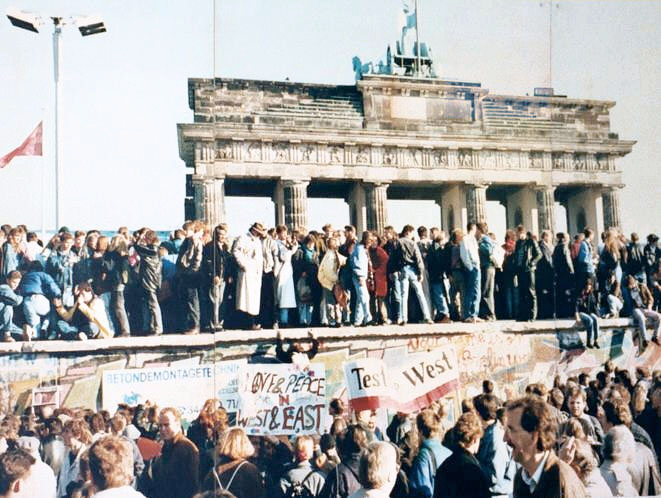On 3 October 1990 the process of reunification of Germany was concluded and as a result the German Democratic Republic (GDR/East Germany) joined the Federal Republic of Germany (FRG/West Germany) and Berlin was reunited into a single city.
After the end of the Second World War, the German state was divided into four occupation zones, controlled by France, Great Britain, the USA and the USSR. With the pulling apart of the USSR and the Western countries, and the beginning of the Cold War, the Allies agreed to combine their occupation zones into one state entity, the Federal Republic of Germany. The Soviet Union was not far behind and created its own dependent state, the German Democratic Republic. The city of Berlin, despite its location in the Soviet part, was split in two, with the western part being granted the status of a free city.
Germany would remain divided for many years. In 1952, however, Joseph Stalin suggested that the state should be unified. The western powers initially agreed, but on the condition that free elections be held in the united Germany, with which Stalin obviously disagreed. Eventually, the idea of unification collapsed and the Soviet Union decided to close all border crossings between the two countries and construction of the Berlin Wall began, deepening the division of the former state.
Another opportunity for unification emerged in the late 1980s and early 1990s. Despite the politicians from both sides having already moved closer together, the breakthrough only came with the holiday season, when crowds of East-German vacationers in Hungary, Czechoslovakia and Poland sought asylum in FRG embassies, paralyzing their everyday activities. These acts were an obvious demonstration of public aversion to the regime. In order to relieve the tension in Hungary, the barbed wire guarding the border with Austria was removed, allowing the Germans to cross the “green border” and so enter Germany through Austria. This event foretold the lifting of the Iron Curtain.
On 7 October 1989, the 40th anniversary of the creation of the German Democratic Republic, the streets saw numerous demonstrations instead of grand celebrations. This climate caused Honecker to resign and, on 7 November, the entire SED Politburo followed suit. On 9 November, the border between the FRG and the GDR was opened to everyone, with no formalities required. In Berlin, crowds of people began to demolish the Berlin Wall. On 8 December, at the Congress of the SED, Prime Minister Modrow stated that the reunification of Germany should not be spoken of at all. Meanwhile at the Bundestag, Helmut Kohl – Prime Minister of the FRG, presented a 10-item plan for the reunification of Germany. Prime Minister Margaret Thatcher was quick to respond, saying that implementation of the plan was out of the question, since it infringed on the inviolability of frontiers guaranteed by the Helsinki Conference of 1975.
Thus a veritable battle for the reunification of Germany began. On 18 March 1990, elections were held in the GDR with the Christian Democrats winning over 40% of the votes. This encouraged Kohl to continue his efforts towards reunification. He announced a guaranteed exchange rate of 1:1 between the eastern and western Deutsche Marks, thus enabling the formation of a monetary union on 1 July 1990.
Despite the German desire and efforts towards unity, the four powers remained responsible for Germany as a whole, as had been guaranteed to the Allies under the Paris Treaty on the Sovereignty of the Federal Republic of Germany, concluded on 23 October 1954. On 5 May, the “2+4 Conference” began in Bonn, involving ministers from East and West Germany and the Four Powers. It ended on 12 September 1990, after heated debates, with the “Treaty on the Final Settlement with Respect to Germany”.
Item 1 of the Treaty stated that the united Germany did not and would not have any territorial claims against other states. The German army would be reduced to 370,000 and the Soviet troops would withdraw by 1994. In addition, the four powers renounced their responsibility for Germany.
On 31 August, the governments of both German states signed the comprehensive “Treaty Between the Federal Republic of Germany and the German Democratic Republic on the Establishment of German Unity” with effect from 3 October 1990. Parliamentary elections were held on 2 December 1990, and the results were as follows: Christian Democrats 44%, Social Democrats 33.5%, Liberals 11%, Alliance '90/Greens 4%, and Communists 2%. The two German states merged.
The unification caused the clash of two economic systems – socialism and capitalism. The situation in the eastern part, more sparsely populated and economically weaker, was much worse. This imposed a huge financial burden on Germany, and over the five year period between 1990 and 1995, the government spent twice the federal budget on the development of the former GDR. The program, known as “East German Economic Reconstruction”, had the aim of creating equal opportunities and introducing the eastern federal states to the free market. In the autumn of 2005, it was announced that the overall costs of reunification amounted to 1.5 - 1.6 trillion Euros.
Despite the reunification, the division into Ossis (“Easties”) and Wessis (“Westies”) was not eradicated, and continued to divide the citizens of this reunited state for years after the formal unification.
By Andrzej Włusek
Bibliography:
W. Czapliński, A. Galos, W. Korta: Historia Niemiec. Wrocław 2010
Erhard Cziomer: Historia Niemiec 1945-1991. Kraków 1992
Jerzy Krasuski: Historia Niemiec. Wrocław 2008
This article was prepared in cooperation with Historykon.pl.
